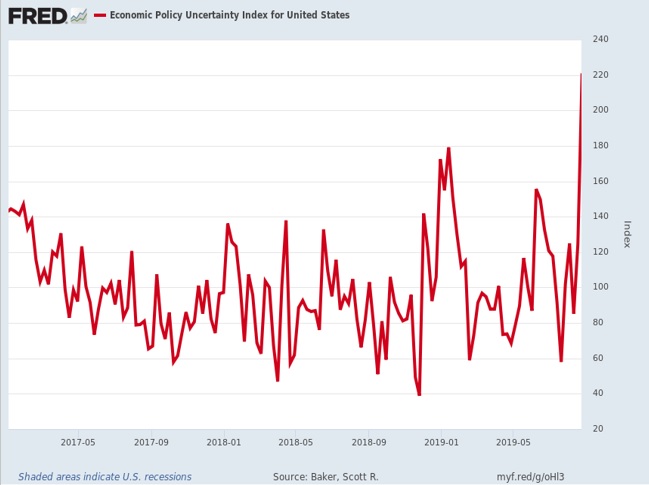Though not something to celebrate, America has reached its highest level of economic policy uncertainty since President Trump’s January 2017 inauguration. It seems that Trump hit a veritable uncertainty bonanza when, in a wide-ranging interview, he indicated that America was winning the trade war even though the trade deficit with China, his preferred measure of success or failure, is rising, and in his opinion, the trade controversy could produce a short recession.
As shown in the attached chart reflecting Federal Reserve data from Scott Baker, Nick Bloom, and Stephen J. Davis, economic policy uncertainty for the week of Aug. 19 rose well above the previous high that had occurred when the government was shut down at the end of 2018. Based on the unhappy relationship between uncertainty and economic performance, this noteworthy achievement predicts lower future per-capita income for Americans.

Then, to cap things off, the president tweeted, “Our great American companies are hereby ordered to immediately start looking for an alternative to China, including bringing your companies HOME and making your products in the USA.”
Closing off markets, forgoing gains from trade, and high-tailing it home hardly seems like winning.
Of course, it must be granted that Trump has access to almost unlimited information on the economy, trade with China, and the inside view on progress with U.S.-China trade negotiations, and may well know that better times are just around the corner, so to speak.
Still, winning doesn’t feel like the right word today. After all, U.S. farmers have been forced to yield their Chinese soybean market to Brazil and are being assisted to the tune of more than $20 billion, borrowed from somewhere, perhaps even China. Add to this the Congressional Budget Office expectation that the average American family will be hit with a tariff-driven bill of $580 in 2020.
Part of the pain ordinary Americans are feeling is captured in the amount of tariffs being collected by the Commerce Department, paid in dollars by Americans each time foreign-produced goods cross U.S. borders. Until the trade war acceleration, Americans were paying about $36 billion annually. The annual rate of tariff payment is now hitting $70 billion.
Apparently, winning doesn’t come cheap.
During the G-7 meeting in Paris, immediately following his “we are winning” interview, the president mentioned “second thoughts” while walking back his directive to American firms and saying he was feeling better about the ultimate agreement outcome with China. He also indicated that a U.S.-Japan trade agreement would soon be announced, and that he would not impose tariffs on Japanese cars.
Once again, uncertainty reigns supreme. Good news mingles with bad, what was demanded one day is revised the next, and tariffs remain the administration’s weapon of choice in building relationships with other nations.
That’s why the U.S.-China tat-for-tat trade war has been going on long enough. Now is the time for negotiating parties and country leaders to bring a little certainty back to the market, to find the compromise position that yields gains to both parties, and end the pain for American consumers.
The time has come to truly win.
Bruce Yandle is a contributor to the Washington Examiner‘s Beltway Confidential blog. He is a distinguished adjunct fellow with the Mercatus Center at George Mason University and dean emeritus of the Clemson University College of Business & Behavioral Science. He developed the “Bootleggers and Baptists” political model.

